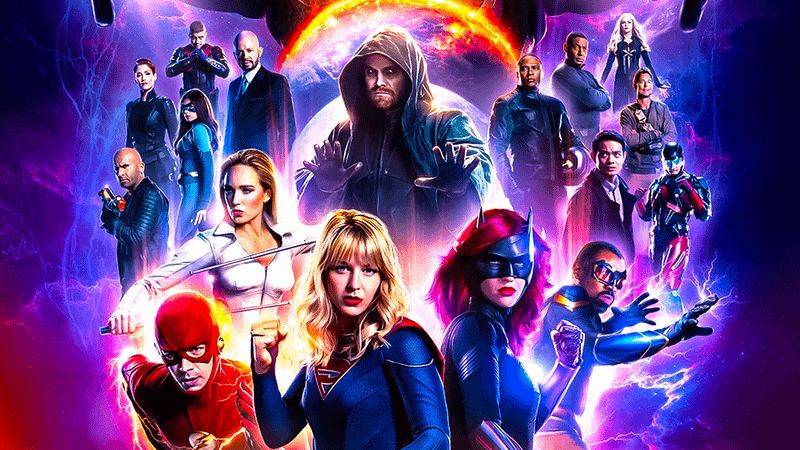
The final movie of the Tomorrowverse just concluded a massive, multi-film crossover adventure.
Crisis on Infinite Earths is perhaps the biggest event in DC Comics history, and it has been adapted in both animated and live-action.
Created by Marv Wolfman and George Pérez, the Multiversal event story brings together all of DC's heroes across the Multiverse as they unite against the Anti-Monitor who threatens to destroy all life.
While the DCEU almost had its own Crisis event on the big screen, there were notable adaptations that made waves over the years.
What Happened After Crisis on Infinite Earths? Every Major Adaptation Explained
The Tomorrowverse

The Tomorrowverse gave its take on the Crisis on Infinite Earths storyline by showcasing a three-part story in animated form.
While the Arrowverse brought together live-action DC heroes together across the Multiverse. the Tomorrowverse did the same as it paid tribute to the DC's animated lineup, most notably Kevin Conroy's Batman from Batman: The Animated Series.
This version of Crisis brutally erased the universes that fans know and love, such as the worlds of Batman: The Animated Series, Superman: The Animated Series, Justice League Dark: Apokolips War, and Earth-1 of the current Tomorrowverse.
The heroes' final stand against the Anti-Monitor made them realize that sacrifices needed to be made, leading to the deaths of Supergirl and Wonder Woman.
Similar to other Crisis adaptations, the only way to stop the Anti-Monitor in this story is to merge the remaining Earths into one prime universe.
With the help of Wonder Woman's sacrifice in the Miracle Machine, the remaining heroes walk into a portal so that they can be reborn on Earth-Prime with new memories and history.
The movie's epilogue shows a new version of a young Diana Prince in Themyscira, hinting that she will be one of Earth-Prime's leaders when a new conflict arises.
The Comics

Marv Wolfman and George Pérez's Crisis on Infinite Earths comics story from 1985 served as the blueprint for most of the adaptations of the famous storyline.
Crisis was made to streamline DC Comics' line of books and avoid confusion from readers while also highlighting the different characters that the company created over the years.
Crisis on Infinite Earths showcased the Anti-Monitor's murder spree in the form of an Anti-matter wave that spread across the Multiverse, destroying every Earth it touched.
The Monitor (the Anti-Monitor's antithesis) recruited worthy heroes from the Multiverse to try and stop the destruction, but he was killed as well.
In an unprecedented move, the remaining heroes and villains are united by the Spectre to ultimately put an end to the Anti-Monitor's reign of Anti-matter terror.
It was not a happy ending for some heroes since a good chunk of them sacrificed their lives to save the Multiverse, most notably Barry Allen (The Flash) of Earth 1 and Kara Zor-El (Supergirl) of Earth-1.
Five main Earths then merged into a single planet known as New Earth, combining Earth 1 (the Justice League's home), Earth 2 (the Justice Society's world), Earth S (a world that includes Shazam and other heroes created by Fawcett Comics), Earth 4 (heroes owned by Charlton comics), and Earth X (Quality Comics' heroes).
As DC Comics enters a reboot, only a villain known as the Psycho Pirate remembers the Multiverse and the events from the pre-Crisis timeline.
Some notable changes include Superman being the sole survivor of Krypton (no Supergirl or Krypto), Batman being an urban legend instead of a well-known hero, and Dinah Lance (the second Black Canary) serving as one of the founders of the Justice League.
Crisis also paves the way for stories like Knightfall and The Death of Superman to take center stage.
The Arrowverse

The Arrowverse's version of Crisis on Infinite Earths introduced their fresh take on the Crisis storyline while also maintaining the core elements from the comics such as the Monitor and Anti-Monitor's involvement, the Spectre, Harbinger, Pariah, and the merging of Earths into one.
The five-part crossover event assembled the heroes of The Flash, Arrow, DC's Legends of Tomorrow, Supergirl, Batwoman, and Black Lightning as they went all-out in protecting the Multiverse from the Anti-Monitor.
The Arrowverse also made history as the first live-action adaptation of the Crisis storyline, including game-changing cameos, such as Tom Welling's Superman, Kevin Conroy's Batman, Brandon Routh's Superman, and Ezra Miller's Flash.
In this version of Crisis, the Monitor assigned seven Paragons as his last resort once all of the Earths across the Multiverse were destroyed by the Anti-Matter wave.
These Paragons fought side by side alongside Oliver Queen as the Spectre to make their last stand against the Anti-Monitor, ultimately leading to the creation of Earth-Prime.
Earth-Prime (the combination of Earth 1 and Earth 38) allowed heroes to easily crossover one another while also cementing an established shared history that incorporated past crossover events in the pre-Crisis timeline.
Unlike the comics, though, the Arrowverse's Crisis ends with the Multiverse still intact, but the main heroes of Earth-Prime were not made aware of it until later on in The Flash Season 9.
A final montage shows that the Arrowverse's Multiverse includes universes featuring worlds inhabited by Doom Patrol, Titans, Stargirl, the Green Lantern Corps., and Swamp Thing.
Justice League: Crisis on Infinite Earths - Part Three is now available on all major digital platforms.












